It brings me so many good memories!!!
It brings me so many good memories!!!
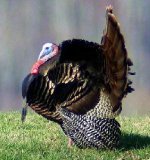 ` `The Turkey Thanksgiving Day celebration will be incomplete without the legendary turykey. The Pilgrims used to call any wild fowl, turkey. The turkey is usually the main course of most household during this celebration. It is a customary dinner which serves as a reminder of the four wild turkeys that were served at the first Thanksgiving feast. 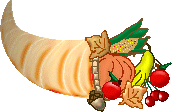 The Cornucopia The Cornucopia s a symbol of nature’s productivity. It is the "horn of plenty" and is the most common symbol of a harvest festival. It is a horn-shaped container or basket that is filled with the abundance of a harvest. The traditional cornucopia was a curved goat’s horn. According to ancient Greek mythology, it was one of the horns of a goat called Amalthaea. The horn could produce ambrosia and nectar which was the food and drink of the gods. This goat supposedly nursed the god Zeus when he was a baby. Zeus later set the goat’s image in the sky known to us today as the constellation Capricorn, to show his gratitude. However, according to Roman mythology, the cornucopia was the horn of Achelous, the river god. The horn was broken off in a fight with Hercules. It was believed that Achelous came in the form of a bull. The water nymphs then filled the horn with flowers and fruit to offer it to the goddess of plenty, called Copia.
The Pumpkin Another symbol of the modern Thanksgiving dinner is the pumpkin pie. The pumpkin is one of the most important symbols of the harvest festival and is an American favorite.
Cranberries Cranberries are a kind of berry. Its name originated from crane berry because of its pink blossoms and drooping head which reminded the Pilgrims of the crane. The Pilgrims found out how to sweeten the bitter cranberries with maple sugar. The cranberry sauce was and is still used as a compabion of turkey during Thanksgiving dinner.  Beans Native Americans taught the Pilgrims to grow beans next to cornstalks. The was so that tbe beans could use the cornstalks as their pole as they grow, hence American beans are also known as Pole beans. Beans are therefore a special symbol of thanksgiving feast. |

Manuel de Falla y Matheu (November 23, 1876 – November 14, 1946) was a Spanish composer of classical music. With Isaac Albéniz and Enrique Granados he is one of Spain’s most important musicians of the first half of the 20th century.
18th November, 1928: Mickey Mouse appears for the first time in Steamboat Willie. It was the first successful sound-synchronized animated cartoon film produced by Walt Disney and premiered at the Colony Theater in NYC (New York City).

WOW!!!!
![]() 30.000 visitors!!!
30.000 visitors!!! ![]()
![]()
![]()
![]()
![]()


![]()

![]()


I’m so happy that we have more than 20.000 visitors since we have a counter!!!!!
Thank you all for making me feel that all the hard work is useful!!!!
THANK YOU!!!

This is the aim I’d like to fulfill along this new school year.
The spirit shown in this video made by a school in Tenerife is a good example to follow. We all can do great things together!!
Hope we really keep this team spirit and we learn lots of new things together!!

Now that September is here, IT’S SCHOOL TIME AGAIN!!!
You’re probably feeling excited and maybe a little sad that summer is over. Some kids feel nervous or a little scared on the first day of school because of all the new things: new teachers, new friends, new knowledge. Luckily, these "new" worries only stick around for a little while.
Let’s find out more about going back to school.
ESTE MENSAJE ES PARA TODOS LOS USUARIOS DE NUESTRO BLOG Y PARA VUESTROS PADRES.
NUESTRO BLOG HA SIDO OBJETO DE SABOTAJE EXTERNO POR PARTE DE ALGÚN TIPO DE HACKER INFORMÁTICO QUE HA CAMBIADO FOTOS PUBLICADAS PARA REEMPLAZARLAS POR FOTOS O COMENTARIOS OBSCENOS.
ESPERAMOS QUE ESTO NO SE REPITA, PERO SI SUCEDE, POR FAVOR, ENTENDED QUE ESTAMOS TRABAJANDO PARA QUE NO OCURRA Y PARA SUBSANARLO LO ANTES POSIBLE.
GRACIAS A TODOS POR VUESTRO APOYO Y NO DUDÉIS EN SEGUIR VISITÁNDONOS Y HACIENDO COMENTARIOS POSITIVOS, QUE ES LO QUE NOS ANIMA A SEGUIR.
BESITOS A TODOS. 
El pasado lunes 21 de junio tuvo lugar el 1er certamen de TALENT SHOW en nuestro colegio.
El objetivo de este festival es que los alumnos de 5º y 6º en particular y la comunidad educativa del centro en general, participen de una actividad lúdica en la que poder mostrar nuestro talento en un escenario delante de nuestros compañeros.
Bajo el lema ¡¡TÚ TIENES UN TALENTO!! pudimos comprobar que en nuestro colegio hay talento y habilidades a raudales y que entre todos somos capaces de preparar un fin de curso divertido, dinámico y muy educativo.
En esta primera convocatoria hemos contado con 54 alumnos participantes divididos en 22 grupos que nos deleitaron con actuaciones de lo más diversas: canto, baile, música instrumental, deletreo, poesía y taekwondo. El broche final lo pusieron tres grupos de profesores bailando, cantando y haciendo malabares.
El jurado, formado por representantes del Claustro de Profesores, un representante del Equipo Directivo, un representante del AMPA y un representante de la Escuela Municipal de Teatro, lo tuvo muy difícil para elegir a los ganadores y repartir los premios otorgados por el Ayuntamiento de nuestro municipio.
Esta 1ª edición del TALENT SHOW ha sido todo un éxito, por lo que pensamos repetir en cursos próximos.
¡Gracias a todos los participantes por vuestro entusiasmo y al público por su colaboración!!!

Este lunes, 21 de junio de 2010 a las 13.28 hora oficial peninsular en el Hemisferio Norte, se inicia la estación más larga del año desde hace algunos siglos, el verano, que durará 93 días y 15 horas, según lo acordado en el convenio astronómico que recoge el Observatorio Astronómico Nacional (OAN), del Ministerio de Fomento.
El inicio de las estaciones viene dado por aquellos instantes en que la Tierra se encuentra en unas determinadas posiciones en su órbita alrededor del Sol. En el caso del verano, esta posición se da en el punto de la eclíptica en el que el Sol alcanza su posición más boreal.
El día que esto sucede, el Sol alcanza su máxima declinación norte y permanece casi sin moverse durante varios días, y por eso, a esta circunstancia se la llama también solsticio o ’sol quieto’ de verano. En este instante en el Hemisferio sur se inicia el invierno.
El día del solsticio de verano corresponde al de mayor duración del año entre la salida y la puesta del Sol en un lugar dado. Así, el próximo día 21 de junio va a ser el día de mayor duración, y por ejemplo, en Madrid esta duración será de 15 horas y tres minutos, a comparar con las nueve horas y 17 minutos que durará el día más corto (el 22 de diciembre).
Esta diferencia de casi seis horas depende de la latitud del lugar, siendo nula en el Ecuador y siendo extrema (24 horas) por encima del Círculo polar ártico. Es precisamente por encima del Círculo polar boreal donde algunos días al año (alrededor del 21 de junio) se da el fenómeno del Sol de medianoche, en que el astro rey es visible por encima del horizonte durante las 24 horas del día. (En la Antártida tiene lugar alrededor del 21 de diciembre)
Alrededor de esta fecha se encuentran el día en que el Sol sale más pronto y aquél en el que se pone más tarde. Un hecho circunstancial no relacionado con las estaciones se da también en esta época: el día del ’afelio’, es decir, el día en que el Sol y la Tierra están más alejados entre sí a lo largo del año.
LA TIERRA SE MUEVE MÁS LENTA
Es este mayor alejamiento al Sol la causa de que la Tierra se mueva más lentamente a lo largo de su órbita elíptica durante el verano (según la conocida como tercera Ley de Kepler) y por lo tanto la duración de esta estación sea mayor.
Además, el día en que el Sol sale más pronto es el 14 de junio, mientras que el día en que se pone más tarde es el 27 de junio. Por estas fechas se da también el máximo alejamiento anual (afelio) entre la Tierra y el Sol. En esta ocasión, se dará el próximo día 6 de julio, siendo la distancia de algo más de 152 millones de kilómetros, unos cinco millones más que a principios de enero, cuando la distancia al Sol alcanza su mínimo anual.
Por otro lado, la actividad del Sol se caracteriza por la presencia en su superficie de manchas, fulguraciones y protuberancias, y en la Tierra, se aprecia en alteraciones en la propagación de las ondas de radio y en una mayor presencia de auroras polares. Esta actividad sigue un periodo de aproximadamente once años, y está asociada al ciclo magnético del Sol.
A lo largo del verano habrá dos eclipses, aunque ninguno de ellos será visible en España tendrán lugar el día 26 de junio uno parcial de Luna, que será visible en el sureste asiático, Australia, regiones del Pacífico y América y que vendrá acompañado de uno total de Sol, que se dará dos semanas más tarde, el 11 de julio, y será visible en el Océano Pacífico Sur y el extremo meridional de Sudamérica.
Durante el mes de julio de 2010 se producirán dos pasos de Júpiter por el Ecuador Celeste; el 8 de julio Júpiter cruza el Ecuador de sur a norte y el 31 de julio el cruce será de norte a sur. Habrá un tercer paso (de sur a norte) que se producirá el 5 de febrero de 2011.
FENÓMENOS ASTRONÓMICOS
La primera Luna llena del verano se dará el 26 de junio, dándose las siguientes 29 ó 30 días después y habrá otras el 26 de julio y el 24 de agosto. Por otro lado, en cuanto a la visibilidad de los planetas, como luceros matutinos se podrá observar a Júpiter y a Urano, que pasarán a ser visibles durante toda la noche en septiembre y agosto respectivamente. Al atardecer se verán Venus, Marte y Saturno.
Concretamente, el día 20 de septiembre se producirá el máximo acercamiento anual de Júpiter a la Tierra. Además, las lluvias de meteoros más intensas del verano son las ’delta Acuáridas’, cuyo máximo ritmo se da alrededor del 30 de julio, y la más famosa del verano, la de ’Las Perseidas’, cuyo máximo se da alrededor del 12 de agosto.
CONSTELACIONES
En cuanto a las agrupaciones ficticias de estrellas conocidas como constelaciones, alrededor de la estrella Polar se verán a lo largo de la noche Casiopea, Cefeo, el Cisne, el Dragón y las dos Osas. De este a sur a oeste se verán Pegaso, el Aguila, la Corona Boreal y la Cabellera de Berenice.
Igualmente, cerca del horizonte se verán a lo largo de la noche algunas de las constelaciones zodiacales, de la Virgen a Acuario, esta última ya cerca del amanecer. Entre las estrellas más brillantes visibles en esta época destacan las que constituyen al ’triángulo veraniego’: Altair (en el Aguila), Deneb (en el Cisne) y Vega (en la Lira).

Este año, la Consejería de Educación ha convocado el II Concurso de Narración y de Recitado de Poesía para alumnos de quinto curso de Educación Primaria escolarizados en centros docentes públicos y privados de la Comunidad de Madrid, que trata de estimular el esfuerzo de los centros educativos, los profesores y los alumnos en el nivel de expresión oral y escrita. Esta segunda convocatoria se ha llevado a cabo en los meses de abril, mayo y junio de 2010.
Ha habido dos modalidades, una de narración y otra de recitado de poesía. Cada centro ha podido seleccionar un máximo de dos alumnos para cada modalidad y se ha celebrado una fase territorial y una final. En la modalidad de narración, el alumno ha dispuesto de una hora para realizar una composición escrita.
En la modalidad de recitado de poesía el alumno ha tenido que aprender de memoria y recitar tres poesías de un repertorio obligatorio para la fase territorial. Para la fase final, a estas tres poesías se ha sumado una cuarta elegida libremente por el alumno.
El curso pasado nuestro colegio salío triunfante en la primera convocatoría del concurso, siendo el ganador de la modalidad de narrativa vuestro compañero de 6ºD David Sanz.
Este año seguimos de enhorabuena, ya que Lucía Guerra sido una de las triufadoras en la modalidad de narrativa y Naiara Molina ha conseguido una mención honorífica en la modalidad de recitado de poesía.
¡¡¡¡¡ENHORABUENA A LAS DOS!!!!!
Isaac Manuel Francisco Albéniz y Pascual (Camprodón, España; 29 de mayo de 1860 – Cambo-les-Bains, Francia; 18 de mayo de 1909) fue un célebre compositor y pianista español
A pesar de ser un famoso compositor de piano, Isaac Albéniz de ningún modo se limitó a la música para dicho instrumento. De hecho, dedicó más de una década de sus casi cuarenta y nueve años en vida a escribir temas para teatro (temas que recibieron recientemente una especial atención con el reestreno de su más exitoso trabajo operístico, Pepita Jiménez, interpretaciones de conciertos y la grabación de Merlín), mientras que intermitentemente durante su carrera escribió canciones -más de dos docenas- así como varios temas orquestales y de cámara.

Los próximos días 18 y 20 de mayo nos vamos a Cercedilla a vivir una nueva aventura en la naturaleza.
Echad un vistazo a la página web en la que encontraréis mucha de la información necesaria para emprender esta aventura.
Sir James Matthew Barrie, 1st Baronet, OM (9 May 1860 – 19 June 1937) was a Scottish author and dramatist, best remembered today as the creator of Peter Pan. The child of a family of small-town weavers, he was educated in Scotland. He moved to London, where he developed a career as a novelist and playwright. There he met the Llewelyn Davies boys who inspired him in writing about a baby boy who has magical adventures in Kensington Gardens (included in The Little White Bird), then to write Peter Pan, or The Boy Who Wouldn’t Grow Up, a "fairy play" about this ageless boy and an ordinary girl named Wendy who have adventures in the fantasy setting of Neverland. This play quickly overshadowed his previous work and although he continued to write successfully, it became his best-known work, credited with popularising the name Wendy, which was very uncommon previously. Before his death, he gave the rights to the Peter Pan works to Great Ormond Street Hospital, which continues to benefit from them.

May 2010 marks the 150th anniversary of Scottish author JM Barrie’s birth. We look at the lasting power of Peter Pan.
When Scotsman James Matthew Barrie scratched the sentence: ’All children, except one, grow up’, on to a piece of paper in his house at Bayswater Road, London, he could never have imagined the lasting impression his words would leave.
They form the opening line to Peter Pan: a tale of fairies and pirates which has enchanted children all over the world for more than a century.
First staged at the Duke of York Theatre, London, 27th December 1904, the popularity of Peter Pan sealed Kirriemuir-born Barrie’s place in literary history forever.
One hundred and fifty years on from his birth, the world remains captivated, just as Peter stays eternally locked in the magic of childhood.
When Barrie died at the age of 77, he had critical acclaim, a baronetcy, an Order of Merit and an impressive list of works to his name. No single work would be remembered, however, like Peter Pan.
Inspired by the five sons of Arthur and Sylvia Llewelyn Davies, whom Barrie met while walking his giant St Bernard dog, Porthos, in Kensington Gardens, Peter Pan has been translated into almost 100 languages.
One of the reasons for the enduring, global, appeal of Peter Pan is its universal theme.
Whether or not we believe in mischievous flying fairies, canine nannies or ticking crocodiles, none of us – except Peter – can escape the reality of growing old.
Barrie knew the play’s widespread appeal would make for enjoyable drama. He did not appreciate how deeply it would enter global consciousness.
Following the success of the stage drama and novel, Peter Pan became the subject of a silent movie. The 1924 film would be the first of many cinematic versions. At that time, it was rumoured Charlie Chaplin – the king of silent cinema – would play Peter.
Amongst Barrie’s friends were Sir Arthur Conan Doyle, H. G. Wells and theatre producer, George Frohman. He enjoyed a lengthy correspondence with Robert Louis Stevenson and was the neighbour of George Bernard Shaw. Barrie, too, was one of the last people Captain Robert Falcon Scott wrote to, before perishing on his return from the South Pole.
In his own lifetime, Barrie saw Peter Pan re-enacted in various forms on stage. The coming of the movie era, however, took it to a level almost incomprehensible.
The Walt Disney Animated Classic version of 1953 made over 87 million dollars in revenue. The 1991 Steven Spielberg movie Hook, starring Dustin Hoffman, Robin Williams and Julia Roberts took 120 million dollars at the box office.
Script writers have continued to see potential in Barrie’s story, and the complex narrative of his own life, beyond the century in which it was written.
The film, Return to Neverland (2002) was a favourite of the late Michael Jackson, inspiring the construction of the singer’s Neverland ranch at Santa Barbara. A year later, Jeremy Sumpter won a Saturn award for his leading role in Peter Pan. Finding Neverland with Kate Winslett and Johnny Depp explored Barrie’s relationships with the Davies family and won an Academy Award and six Oscar nominations.
While Peter Pan – the story – has continued to delight youngsters the world over, it has also helped in the care of sick infants for over 80 years.
Barrie gifted the rights to Peter Pan to Great Ormond Street Hospital in London in 1929. It still receives royalties from all productions and publications.
"It was an inspired legacy, an amazing gift," admits Christine De Poortere, Peter Pan Director of Great Ormond Street Hospital Children’s Charity. "It has been successful, not just in terms of royalties, but as a symbol of the hospital itself."
Today, Peter Pan still inspires new publications, comics, fairground rides and even Nintendo video games. Its adaptations include a live action musical for Belarussian TV. There are seven Peter Pan statues worldwide and three race horses have taken its name. The first phase of a £340,000 project to create a Neverland themed play area in Barrie’s hometown of Kirriemuir is underway, ensuring the children of the Little Red Town continue to benefit from their favourite son.
Visitors to Barrie’s hometown are expected to soar in this anniversary year. In Kirriemuir, you can visit the cottage at 9 Brechin Road where the author was born. The adjacent house contains an exhibition and the outside wash-house, supposedly Barrie’s first theatre, still stands. Barrie is buried in Kirriemuir Cemetery and on the scenic Kirriemuir Hill, the pavilion and camera obscura gifted to the town by Barrie in 1930 stands proudly over the Angus countryside – a reminder of his time there and his legacy.

El Día de la Madre o Día de las Madres es una festividad que conmemora a las madres. Se celebra en diferentes fechas del año según el país. El moderno Día de la Madre fue creado por Julia Ward Howe, en 1870, originalmente como un día de madres por la paz, que luego derivó en un día para cada familia en honor a su madre y se ha convertido en una fiesta en muchos lugares del mundo.
Las primeras celebraciones del Día de la Madre se remontan a la antigua Grecia, donde se le rendían honores a Rea, la madre de los dioses Zeus, Poseidón y Hades.
La Encyclopædia Britannica dice: "Una fiesta derivada de la costumbre de adorar a la madre en la antigua Grecia. La adoración formal a la madre, con ceremonias a Cibeles, o Rea, la Gran Madre de los Dioses, se ejecutaba en los idus de marzo por toda Asia Menor".
Igualmente los romanos llamaron a esta celebración La Hilaria cuando la adquirieron de los griegos y se celebraba el 15 de marzo en el templo de Cibeles y durante tres días se hacían ofrendas.
Los primeros cristianos transformaron estas celebraciones en honor a la Virgen María, la madre de Jesús. En el santoral católico el 8 de diciembre se celebra la fiesta de la Inmaculada Concepción, fecha que se mantiene en la celebración del Día de la Madre en algunos países como Panamá.
En Inglaterra hacia el siglo XVII, tenía lugar un acontecimiento similar, también a la Virgen, que se denominaba Domingo de las Madres. Los niños concurrían a misa y regresaban a sus hogares con regalos para sus progenitoras
La mayoría de los países lo festejan en mayo, frecuentemente un segundo domingo de mayo.
The Story of Earthday
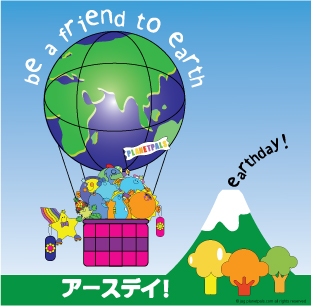
| Earth Day i in the Spring Every Year. |
What is Earth Day?
Earth Day was started in 1970 by a man named John Mc Connell from the United States. It was originally held on the annual celebration of the March Equinox and still is by many people. However, it is generally celebrated on April 22. Earth day is now celebrated worldwide.
When is Earth Day and Earth Month?
The UN designated April 22 Earthday and April earth month.
What is the History of Earth Day?
Earth Day is a very special day specifically designed for all of us to think about earth issues . It is not only a special day in the town where we live, but a day that the whole world participates in! Often there are celebrations, events or campaigns that concern us with earth matters.
Some towns have Earth Day celebrations, and some people and groups participate in Earth Day project.
You can participate in one of the existing projects, or start one of your own. Perhaps a small project with your mom or dad such as planting a tree, or a large project with your classroom or neighborhood friends such as a park clean up. The possibilities are endless. Try to think of something you would like to do-you too, can make a difference!
Don’t miss the ![]() Earth Day Pages for special fun activities, crafts and games to do in celebration of this Earth Day! It’s jam packed!
Earth Day Pages for special fun activities, crafts and games to do in celebration of this Earth Day! It’s jam packed!
See more Earth Day activities pages, full of ideas to make Earth Day a meaningful day!
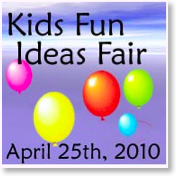
Next Sunday April 25th we’ll be participating in the second annual edition of the Kids in Madrid Fair. This unique children’s fair provides information on English language activities, camps, theatre, extracurricular activities and much more. Throughout the day there will be workshops, raffles, theatre, games, contests and music. We had a great time at last year’s fair, and we look forward to seeing many of you there on Sunday!
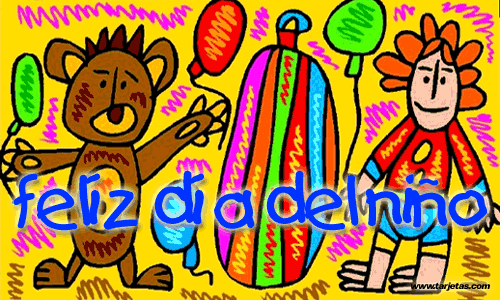
Esta festividad, consagrada a la fraternidad entre los niños del mundo, busca promocionar los derechos de la infancia.
Tradicionalmente se ha celebrado en diferentes fechas dependiendo del país. por ejemplo, en Brasil el 12 de octubre, en México el 30 de abril, en Venezuela el tercer domingo de junio.
Aunque en España se celebraba el 15 de abril, la mayoría de los festejos y actividades relacionados con el bienestar de la infancia se celebran actualmente el 20 de noviembre, coincidiendo con la fecha que las Naciones Unidas recomendó instituir en todos los países. No obstante, no hemos querido olvidarnos hoy de homenajear a los más pequeños.